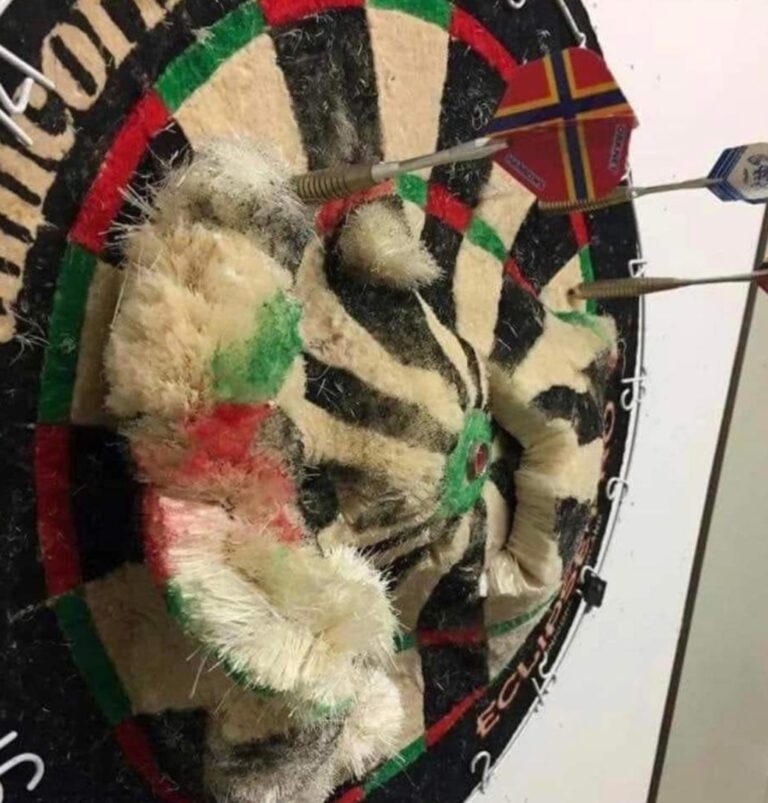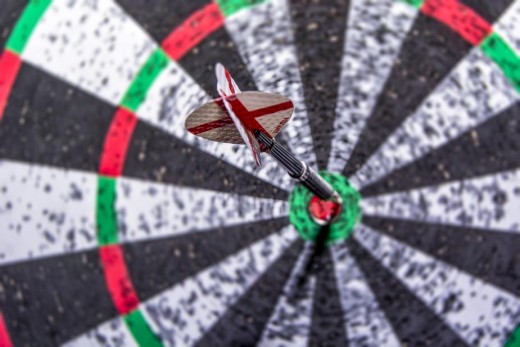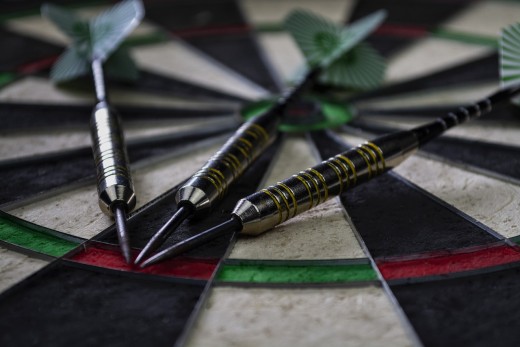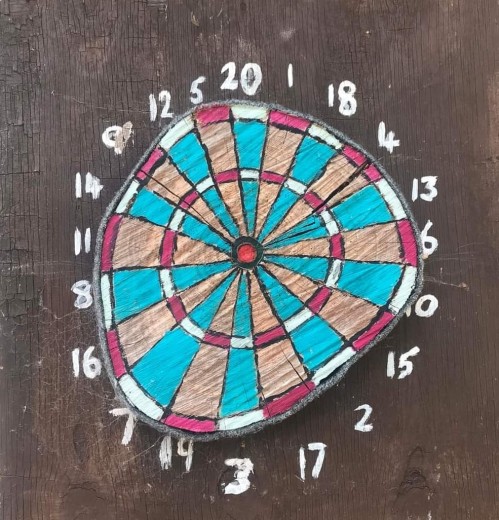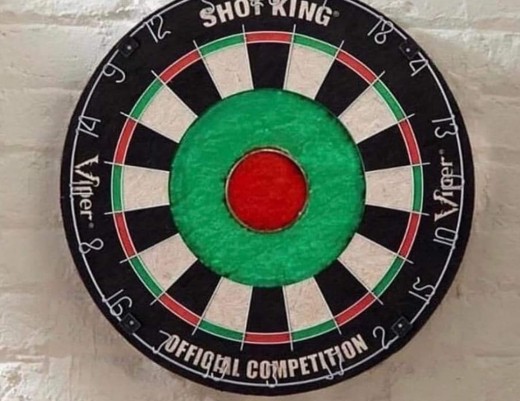Friday, November 1, 2024
Column 674
How to Become a Superior Chalker
The Ten Commandments for Keeping Score
Scorekeepers SHALL NOT:
1. Talk while keeping score!
2. Move about while keeping score. Stand still!
3. Look at the shooter. Stand facing the board!
4. Call out a score, of one dart or all three – unless the shooter asks you!
5. Tell a shooter what to shoot or what combination to shoot for an out!
6. Change a score unless it is brought to the attention of both shooters (teams).
7. Change a score – regardless – if that player (team) has shot again and a second score written down. An error in a shooter’s score MUST be corrected before he or she (or the team) shoots again, or it stands.
8. Lean out to see where a dart is or is going nor shall he or she follow the darts with body or head movement!
9. Show any sign of disgust or excitement while at the scoreboard!
10. Change the side of the score sheet of the player in three (or more) leg matches (if you start a player on the left side of the score sheet, continue to keep his or her score on the left – regardless of what the bull shots are.
– Sarah Parsons
Everywhere I go, I carry a dozen or so manila file folders of unfinished columns. When I have a thought (I do have thoughts! I do have thoughts!) I find a pen, jot down the idea, and shove it in the appropriate file for future reference. Then I lose the file!
One of my more tattered files is labeled “chalking” (which means I have had many of my best thoughts while hiding in the bathroom). I’ve carried it with me for years. It’s stuffed with napkins and beer coasters, smothered with notes.
For some reason I’ve never been able to write the story. I’ve known what I wanted to write. I just have never been able to put the right words to paper.
The other day I FOUND them!
The problem is, they were written by someone else.
His name is Karl Hartman. I discovered his writing at Erik McVey’s old darts forum, www.SEWA-darts.com. The site began as a portal for darters in the Tri-Cites, Washington area, but the forum turned into one of the most frequented in America and the world. The likes of Bob Anderson and John Part posted regularly. And of course, Karl.
Originally from Newport Beach, California, for many years Karl has lived in South Korea, first in Tae-chon and then Gong-ju, where he was (and still is, as far as I know) part owner of a small English school – and a Kimchi connoisseur. Thanks to the old SEWA forum we became online friends and eventually met up for a couple of nights of darts in South Korea and then even roomed together at an old Desert Classic in Las Vegas.
I don’t know how, but somehow Karl weaseled his way into my file, read my drunken scrawls, and wrote the story that I never could. And what he wrote is as good as I could have hoped to do.
So, toss out Sarah Parson’s old Ten Commandments of Chalking. “If (to borrow a one of Karl’s lines), you’re a beginning dart player who has difficulty chalking,” the following words are for YOU.
It’s my pleasure to introduce Karl’s writing. He’s a very funny guy…
__________________________________
The Stages of Chalker Development
Transitioning from Beginner into Mediocrity
So, you are a beginning dart player who has difficulty chalking. Perhaps it’s the pressure of performing addition and subtraction under the intense excitement of a game. Perhaps it’s the fear of having a dart flung into your ear. Whatever the reason, here are some tips I have put together for beginners.
After years of observing mediocre chalkers, I have discovered that all chalkers must move into mediocrity before they can become really good. By following these simple tips, you can elevate yourself from absolute beginner to mediocrity in only a few short weeks.
Please keep in mind, these are the absolute minimum requirements to be a mediocre chalker and can be used in any darting competition. I wish you luck on your journey…
STEP 1: To make the move into mediocrity you should chalk the scores of one team on the outer column of the scoreboard and their totals on the inner column. Then write the opposite team’s scores on the inner column of the scoreboard and their totals in the outer column. Take special care to insure scores are written with larger numbers than the totals. This helps the darters to pay close attention to the game. Drawing sexy little hearts or titties for circles or using your favorite abbreviations (such as “C” for “Chips”) will go a long way towards advancing you to mediocrity.
STEP 2: The mediocre chalker always talks to the darters as they pull their darts. It may be extremely useful to engage the shooter in a discussion about the angle of the darts as they lie in the board, how fast or slow the dart was traveling, or your recent root canal. Almost any topic works for the mediocre chalker.
STEP 3: A good mediocre chalker will always find a reason to move about. He or she may bob up and down to the tune (or voices) they hear over and over again in their head. They may even want to sing along (or argue with the voices). While they are doing that, in an amazing display of aptitude, they also learn to score each dart as it is thrown. They correct errors, or erase and rewrite scores, while the darters are throwing. The hallmark of a mediocre chalker is ordering a beer from a waitress and then endlessly digging in their pockets to find the money to pay for it. “Thaasophobia” (the fear of being idle) is a common illness of the mediocre chalker – there are many diagnosed cases to be found at any blind draw competition. The mediocre chalker never takes their medication.
STEP 4: To be an effective mediocre chalker you must learn to constantly look over your shoulder at the oche to see if a darter is ready to throw. Try to catch him or her at the moment the arm begins its forward motion. With practice you can become quite good at this. It is a great way for beginning chalkers to learn about holding and throwing darts while propelling themselves quickly into mediocrity.
STEP 5: In the quest for mediocrity, learn to call out the scores. Call out the scores of each dart thrown as fast as you can. Try to call the scores before the dart hits the board. This lets the thrower know you are paying attention while verifying his or her assessments. This also helps you to practice your addition and subtraction because when you call out a score that the shooter does not agree with, he or she will help you to correct it immediately.
STEP 6: A true mediocre chalker will frequently tell the shooters what to shoot. This helps each match to move a little quicker because fewer errors will be made, and it allows the chalker to gain the respect of the shooters by demonstrating an understanding of the game.
STEP 7: A mediocre chalker can make errors in score keeping and then attempt to change them after the same player has shot again. A sign of someone who has truly made the transition from beginner to mediocrity is the person who can wait until the final double has been hit to spring the surprise on the two teams. Oops, there was a mistake in the third round, you have 10 more points. Sorry, the double does not count!
STEP 8: Mediocre chalkers always follow darts with head and body movements. They also lean in to check the position of every dart thrown. The accomplished mediocre chalker will have the ability to anticipate throws and begin their head movement early so that they get a good look at the dart in flight. Sometimes on their way to excellence, they can keep track of the flight of darts into several boards at the same time.
STEP 9: Mediocre chalkers find ways to let the players know if their shots are good or bad by offering immediate feedback. Raising a finger to indicate “one mark” is a good example; another is to rush from the scoreboard to the oche and high-five or belly-slam the shooter. Exclamations of approval and sighs of disapproval will help the player to do better on his or her next shot and confirm that you have advanced from beginner to mediocre.
STEP 10: Finally, to make the game fair, like tennis, volleyball or football, a person striving for mediocrity should switch the player’s names on the chalkboard after every game. This really gets the teams to pay attention, and it will hasten your journey from “Beginner Level Chalker” into “Mediocrity.”
__________________________________
So, there you have it, Karl Hartman’s Ten Stages of Chalker Development – the NEW rules of scorekeeping.
Read them.
Ignore them.
And become a superior chalker overnight.
From the Field (with thanks to my old friend Karl Hartman),
Dartoid


